冷起动的难易是柴油机重要性能指标之一,柴油机冷起动时,压缩终了温度低、可燃混合气的组成及品质恶化、摩擦损耗大、蓄电池性能下降、柴油机起动阻力增大等因素导致其冷起动困难[1].我国高原面积占国土面积的37%,高海拔地区低气压、低温双重因素对柴油机起动性能造成了严重的影响[2].采用较低的压缩比是限制柴油机最高爆压的重要手段[3],同时也是降低柴油机氮氧化物和颗粒物排放达到更高排放标准的最具前景的技术路线之一[4].但是,低压缩比柴油机的压缩终了温度较低,导致柴油机高原起动性能更加恶化.因此,研究柴油机,尤其是低压缩比柴油机,在高原条件下起动性能的改善措施具有重要意义.
采取措施改善柴油机起动性能是目前的研究热点,国内学者进行了大量的研究工作.主要包括优化喷油参数[5-7]、调节排气门关闭正时[8]、提高压缩比[9]等柴油机设计参数的改进,以及进气预热[10]、燃烧室电热塞[11]、冷却液加热[12-13]等起动辅助措施.例如,梁金广等[14]以CA498Z型电控柴油机为对象,试验研究了进气预热对电控柴油机起动转速、起动时间、碳氢污染物排放的影响规律.杜巍等[15]试验研究了进气预热对柴油机起动特性的影响.刘忠长等[16]在一台直喷式柴油机上,利用缸压和单循环采样测试系统研究了冷却液温度对柴油机起动过程初期燃烧不稳定性及排放的影响规律.Gazon M等[17]在一台4缸16气门直喷柴油发动机上,研究了冷却液温度对柴油机起动过程怠速阶段放热率和燃烧噪声等特性的影响.然而,上述研究均针对柴油机平原低温起动工况,关于加温辅助措施对低压缩比柴油机在不同海拔条件下起动过程的影响研究未见报道.
柴油机高原起动时,升速期增长,燃烧不稳定,出现做功能力不同的燃烧形态,是导至升速转速波动,起动变差的主要原因[18-19].本文以一台低压缩比6缸增压直喷柴油机为研究对象,利用高原模拟试验系统,试验分析进气加热、冷却液加温辅助措施在不同海拔下对柴油机起动性能的影响规律,以及柴油机起动过程不同阶段燃烧形态的变化规律,为低压缩比柴油机高原起动性能的改善提供参考依据.
1 试验系统及方案试验发动机为一台压缩比14.25,缸径150 mm,行程160 mm,增压中冷、四冲程6缸柴油机.试验装置包括德国Imtech公司的发动机高原环境进排气模拟试验系统, 大气压力控制范围57.57~101.3 kPa,可模拟0~4 500 m海拔条件.检测设备包括DEWETRON燃烧分析仪,霍尔式转速传感器,Kistler进气压力、排气压力传感器,其中转速、缸压、进排气压力的采样频率为0.1 ℃A.试验系统如图 1所示.

|
图 1 高原环境模拟试验台 Fig.1 Test system of platean simulation |
依据GB/T 20969.1—2007,按照表 1所示的环境条件模拟0、3 000、4 500 m海拔高度,在环境温度20 ℃、相对湿度25%条件下进行冷态起动试验,进气加热起动试验,以及无进气加热条件下冷却液分别加热到30、40、50和60 ℃的不同冷却液温度起动试验.
| 下载CSV 表 1 试验环境参数及进气加热温度 Tab.1 Ambient condition at different altitudes and intake heating temperatures |
柴油机起动过程可以划分为柴油机在外力拖动下开始转动,至转速开始持续上升前的初始期; 发动机转速持续上升,直至上升到最高转速的升速期; 以及发动机转速稳定在某个转速持续运转的怠速期3个阶段.对该低压缩比柴油机不同海拔起动的初始期、升速期及稳定期进行统计.图 2为该低压缩比柴油机平原(0 m)、高原(3 000、4 500 m)冷态起动时转速曲线,以及起动过程中初始期、升速期、稳定期的变化情况.
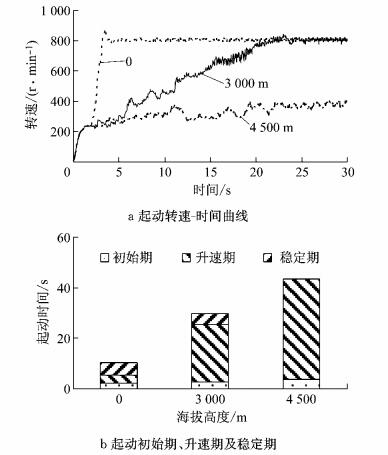
|
图 2 海拔高度对柴油机起动性能的影响 Fig.2 Effect of attitude on start-up performance of diesel engine |
由图 2a可见,该柴油机起动过程中,随着海拔的升高,初始期基本没有变化,升速期迅速延长.4 500 m起动时,直到起动后30 s,柴油机仍没有进入怠速,起动失败.由图 2b可见,与平原(0 m)比较,3 000、4 500 m高原起动该柴油机升速期分别增长6.7和11.8倍.因此,升速期迅速延长是导致该柴油机高原起动性能恶化的主要原因.楼狄明等[18]也得到类似的结论.柴油机高原起动时,升速期出现单母峰、双峰、子孕峰和失燃4种做功能力不同的燃烧形态,使燃烧做功能力变化,进而导至升速转速波动,起动时间增长[19-20].图 3为该柴油机平原(0 m),高原(3 000、4 500 m)冷态起动时不同燃烧形态的出现规律.
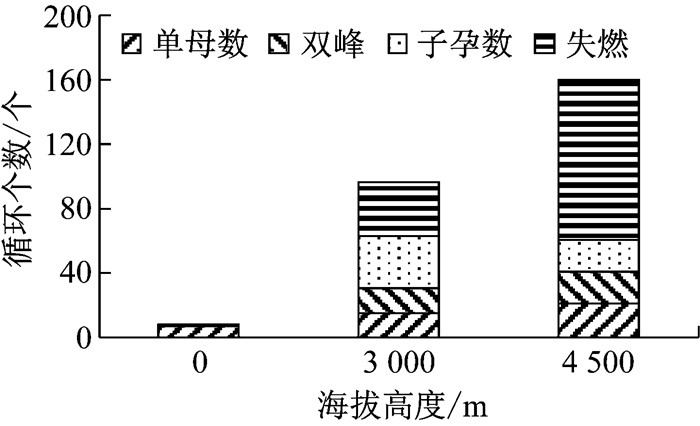
|
图 3 海拔高度对柴油机起动燃烧形态的影响 Fig.3 Effect of altitude on combustion morphology of diesel engine |
由图 3可见,平原起动时,共经历8个循环,单母峰、双峰、子孕峰和失燃循环个数分别为7、0、0、1个; 3 000m海拔起动时,循环个数增加到96个,单母峰、双峰、子孕峰和失燃循环个数分别为15、16、34和31个; 4 500 m海拔起动时,在起动未成功的情况下,循环个数已经增加到160个,单母峰、双峰、子孕峰和失燃循环个数分别为21、19、20和100个.因此,随着海拔高度的增加,该柴油机起动过程中做功能力强的单母峰和双峰比例减小,做功能力较差的子孕峰出现,做负功的失燃循环数量比例明显增加.3 000、4 500 m起动,失燃循环占循环总数分别达到35.4%和62.3%.所以,低压缩比柴油机高原起动时,燃烧滞燃期变长,燃烧重心后移[20],导致升速期内做功能力差的子孕峰和做负功的失燃循环数增加,起动性能恶化.因此,采取措施,改善低压缩比柴油机起动过程的燃烧,是改善低压缩比柴油起动性能的重要手段.
2.2 冷却液加温对低压缩比柴油机起动性能的影响冷却液加温是通过燃油燃烧器使燃料燃烧,将热量通过热交换传递给冷却液来加热整机及润滑油的升温起动辅助措施.发动机被加热后,一方面,压缩终了的温度提高,有利于起动; 另一方面,气缸、活塞、活塞环等摩擦副之间的机油温度提高,黏度降低,摩擦阻力减少,有利于减少起动时间[21].图 4为平原(0 m)、高原(3 000、4 500 m)不同冷却液温度条件下,试验样机起动过程中初始期、升速期、稳定期的变化规律.

|
图 4 0、3 000、4 500 m海拔冷却液温度对起动初始期、升速期、稳定期的影响 Fig.4 Effect of coolant temperature at an altitude of on initial, speed-up, and stable period during engine start-up process 0, 3 000, and 4 500 meters |
由图 4可见,0、3 000和4 500 m海拔高度下,随着冷却液温度的升高,该柴油机起动初始期、升速期和稳定期均有所改善.平原条件(0 m)下,冷却液温20 ℃(冷态)起动,其初始期、升速期和稳定期时间分别为2.02、3.40和4.90 s; 当冷却液温度升高到30 ℃时,起动初始期、升速期和稳定期分别缩短到2.00、1.58和3.13 s,分别缩短1.21%、53.56%和36.15%,升速期缩短最为明显; 当冷却液温度升高到40 ℃时,起动初始期、升速期和稳定期进一步缩短,但减少程度变小; 当冷却液温度超过40 ℃后,冷却液温度进一步升高对柴油机起动性能没有进一步的改善效果.海拔3 000 m条件下,当冷却液温度升高到30 ℃时,起动性能明显改善,与冷态(20 ℃)比较,初始期、升速期和稳定期分别降低25.38%、88.65%和1.23%;当冷却液温度升高到40 ℃时,升速期比冷态减少91.61%,稳定期减少73.85%,起动时间进一步缩短; 与平原(0 m)类似,冷却液温度超过40 ℃后,冷却液温度进一步升高对柴油机起动性能改善效果不大.海拔4 500 m,当冷却液温度升高到30 ℃时,柴油机从无法起动改善为可以起动,初始期降低46.22%,升速期降低72.29%;当冷却液温度进一步升高到40 ℃时,其起动时间大幅度减少,初始期、升速期分别降低45.95%和92.05%,起动性能与平原相当.综上所述,冷却液温度升高可减少柴油机起动过程的初始期、升速期和稳定期,对升速期的改善效果最好,且海拔升高,冷却液温度对升速期的影响变大.当冷却液温度超过40 ℃后,进一步升高冷却液温度对该柴油机的起动性能改善效果不明显.
为进一步分析冷却液升温对起动性能的影响机理,图 5为平原(0 m),高原(3 000、4 500 m),不同冷却液温度条件下试验样机起动过程单母峰、双峰、子孕峰、失燃4种燃烧形态随冷却液温度升高的变化情况.
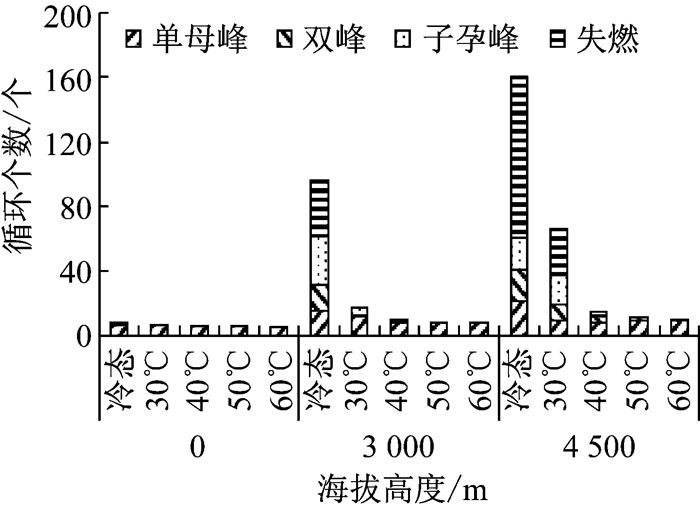
|
图 5 0、3 000、4 500 m海拔冷却液温度对起动燃烧形态的影响 Fig.5 Effect of coolant temperature at an altitude of 0, 3 000 and 4 500 meters on combustion morphology during engine start-up process |
由图 5可见,随着冷却液温度的升高,所有海拔高度柴油机起动经历的循环个数变少,起动时间变短.高原(3 000、4 500 m)起动时,随着冷却液温度的升高,起动过程中做功能力差的子孕峰和做负功的失燃循环个数减少.3 000 m海拔冷却液温度30 ℃时起动的子孕峰循环个数由冷态起动的31个减少到4个,失燃循环基本消失,循环总个数由96个减少到17个.4 500 m海拔,冷却液温度分别为20 ℃(冷态)、30 ℃、40 ℃时,起动循环个数分别为161、44和14个,子孕峰循环个数分别为20、18、1个,失燃循环个数分别为100、29、1.因此,高原起动时,随着冷却液温度的升高,压缩终了温度升高,有利于燃烧性能的改善,起动过程中做功能力差的子孕峰和做负功的失燃循环个数减少,做功能力恢复,起动性能改善.当冷却液温度达到某个温度界限后,做功能力差的子孕峰和做负功的失燃循环出现机率也相应降低到一个较低的水平,此时,再升高冷却液温度,虽然压缩终了温度进一步升高,但其对子孕峰和失燃循环的出现机率改善效果不再明显,起动性能变化不大.
2.3 进气加热对低压缩比柴油机起动性能的影响进气加热可以提高进气温度,进气温度的提高可以显著提高压缩终了温度,有利于燃烧室内燃料的蒸发与雾化.另外,火焰进气加热可把部分燃烧活性成分引入到燃烧室中,在一定程度上增加了燃烧室的残余废气量,有利于促进起动过程中燃烧化学反应的进行,减少滞燃期,改善起动性能[22-23].图 6和图 7分别为平原(0 m)、高原(3 000、4 500 m),进气加热对试验样机起动初始期、升速期及燃烧形态的影响.
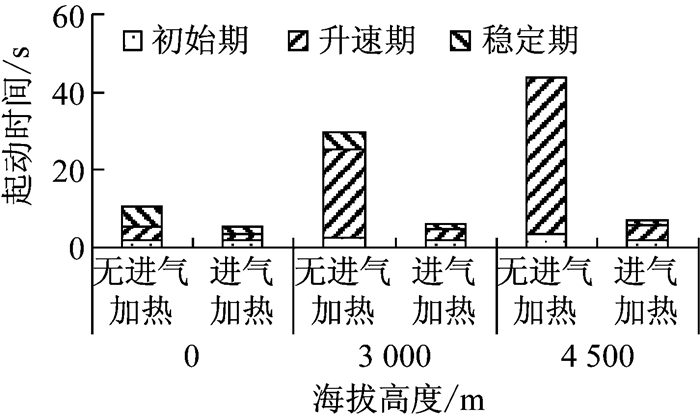
|
图 6 0、3 000、4 500 m海拔进气加热对起动初始期、升速期和稳定期的影响 Fig.6 Effect of intake heating at an altitude of 0, 3 000, 4 500 meters on initial, speed-up, and stable period during engine start-up process |
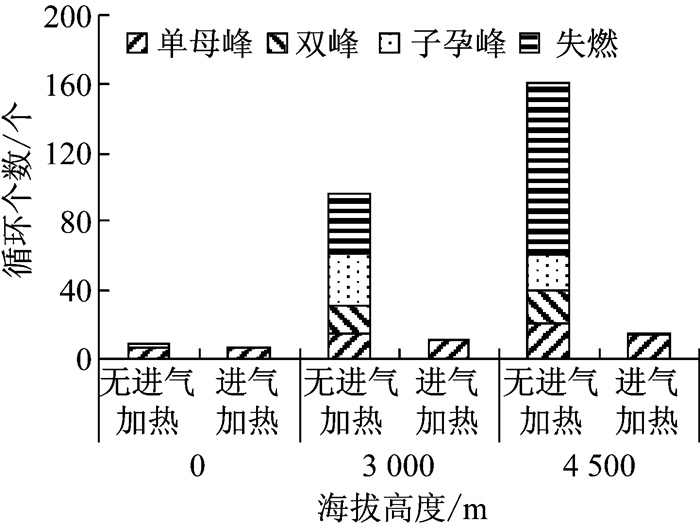
|
图 7 0、3 000、4 500 m海拔进气加热对起动燃烧形态的影响 Fig.7 Effect of intake heating at an altitude of 0, 3 000 and 4 500 meter on combustion morphology during engine start-up process |
由图 6可见,进气加热可以减小柴油机起动过程中的初始期,并大幅度降低升速期时间.由图 7可见,3 000和4 500 m海拔条件下,进气加热可大幅度降低失燃循环的出现,改善起动性能.
3 结论本文以一台低压缩比增压直喷柴油机为试验样机,研究了冷却液温度、进气加热对不同海拔条件下柴油机起动性能的影响,得到如下结论:
(1) 随着海拔的升高,低压缩比柴油机起动初始期基本没有变化,升速期迅速延长.同时升速期出现做功能力差的子孕峰循环和做负功的失燃循环,降低了燃烧做功能力,起动时间增长.
(2) 冷却液加温起动可明显减少柴油机起动升速期子孕峰和失燃循环个数,恢复做功能力,起动性能改善.当冷却液温度到达某个温度界限后,进一步升高冷却液温度对子孕峰和失燃循环的出现机率降低效果不再明显,起动性能变化不大.
(3) 进气加热可大幅度减少柴油机起动过程中失燃循环的出现,明显降低升速期时间,改善起动性能.
| [1] |
何西常, 张众杰, 张云龙, 等. 柴油机冷起动研究现状[J]. 内燃机, 2012(4): 1 HE Xichang, ZHANG Zhongjie, ZHANG Yunlong, et al. Existing status of diesel engines' cold-starting[J]. Internal Combustion Engines, 2012(4): 1 |
| [2] |
高轩, 刘泽坤, 董素荣. 低气压低温环境对柴油机起动性能的影响及改进措施[J]. 内燃机与配件, 2016(5): 1 GAO Xuan, LIU Zekun, DONG Surong. Effects and countermeasures of low atmospheric pression and temperature emvironment on starting performance of diesel engine[J]. Internal Combustion Engine & Parts, 2016(5): 1 |
| [3] |
彭海勇. EGR对柴油机起动过程燃烧排放性能影响的研究[D]. 上海: 上海交通大学, 2010. PENG Haiyong. Study on combustin and emissions of DI diesel engine during stating with EGR[D]. Shanghai: Shanghai Jiao Tong University, 2010. |
| [4] |
OGAWA H, MIYAMOTO N, KAWABE T, et al. Characteristics of unburned hydrocarbons in a low compression ratio diesel engine(characteristics under transient operation and reduction with low distillation temperature fuels[J]. Transactions of the Japan Society of Mechanical Engineers(Part B), 2008, 74(7): 731 |
| [5] |
周广猛, 刘瑞林, 戈非, 等. 高压共轨柴油机低温起动过程试验研究[J]. 汽车技术, 2011(11): 43 ZHOU Guangmeng, LIU Ruilin, GE Fei, et al. Experimental study on cold start process of high pressure common-rail diesel engine[J]. Automobile Technology, 2011(11): 43 DOI:10.3969/j.issn.1000-3703.2011.11.011 |
| [6] |
王政, 王艳利, 刘威, 等. 优化喷油泵参数提高柴油机冷起动性能[J]. 现代车用动力, 2010(4): 35 WANG Zheng, WANG Yanli, LIU Wei, et al. Improve diesel engine's cold-start performance by optimize parameters of injection pump[J]. Modern Vehicle Power, 2010(4): 35 |
| [7] |
楼狄明, 阚泽超, 胡志远, 等. 喷油策略对低压缩比柴油机不同海拔起动性能的影响[J]. 同济大学学报(自然科学版), 2017, 45(4): 582 LOU Diming, KAN Zechao, HU Zhiyuan, et al. Effects of the fuel injection strategy on low compression ratio diesel engine during cold start at different altitudes[J]. Journal of Tongji University(Natural Science), 2017, 45(4): 582 |
| [8] |
彭海勇, 崔毅, 邓康耀, 等. 排气门正时对柴油机冷起动性能的影响[J]. 燃烧科学与技术, 2009, 15(1): 82 PENG Haiyong, CUI Yi, DENG Kangyao, et al. Cold startability of diesel engine under different exhaust valve closing timing conditions[J]. Journal of Combustion Science and Technology, 2009, 15(1): 82 |
| [9] |
马修真, 王忠巍, 王冬. 基于改变压缩比的新型柴油机冷起动辅助装置[J]. 大连交通大学学报, 2004, 25(3): 35 MA Xiuzhen, WANG Zhongwei, WANG Dong. Development on new auxiliary device based on compression ratio change for diesel engine cold start[J]. Journal of Dalian Railway Institute, 2004, 25(3): 35 |
| [10] |
张怡军, 段春霞. 进气预热对柴油机低温起动影响的分析[J]. 内燃机与动力装置, 2008(3): 10 ZHANG Yijun, DUAN Chunxia. Research on effect of air intake preheating on engine start ar low temperatureenginestart at low temperature[J]. Internal Combustion Engine & Powerplant, 2008(3): 10 |
| [11] |
王忠巍. 柴油机冷起动措施的研究[D]. 大连: 大连铁道学院, 2004. WANG Zhongwei. The research of method for diesel engine' cold starting[D]. Dalian: Dalian Railway Institute, 2004. |
| [12] |
刘震涛, 韩松, 尹旭, 等. 发动机冷起动暖机过程改善措施的试验研究[J]. 汽车工程, 2012, 34(7): 596 LIU Zhentao, HAN Song, YIN Xu, et al. An experinmental study on the measures for improving cold start/warm-up process of engine[J]. Automotive Engineering, 2012, 34(7): 596 |
| [13] |
曹志义, 刘胜. 发动机低温起动加温锅性能匹配研究[J]. 小型内燃机与摩托车, 2010, 39(6): 18 CAO Zhiyi, LIU Sheng. Study on matching the performance of fuel fired heater to cold start[J]. Small Internal Combustion Engine and Motorcycle, 2010, 39(6): 18 |
| [14] |
梁金广, 于秀敏, 王云开. 进气加热对电控柴油机起动性能影响的研究[J]. 汽车技术, 2007(2): 29 LIANG Jinguang, YU Xiumin, WANG Yunkai. Research for the influence of air intake preheating on electronic controlled diesel engine starting ability[J]. Automobile Technology, 2007(2): 29 |
| [15] |
杜巍, 黄伟伟, 何圣华, 等. 进气预热对柴油机起动过程动力性能影响的试验分析[J]. 车用发动机, 2015(2): 28 DU Wei, HUANG Weiwei, HE Shenghua, et al. Effect of intake preheating on diesel engine power performance during starting process[J]. Vehicle Engine, 2015(2): 28 |
| [16] |
苏岩, 刘忠长, 许允, 等. 冷却液温度对柴油机起动首循环燃烧的影响[J]. 内燃机学报, 2007, 25(3): 202 SU Yan, LIU Zhongchang, XU Yun, et al. Effect of coolant temperature on the first cycle combustion of diesel engine under start operation[J]. Transactions of CSICE, 2007, 25(3): 202 |
| [17] |
GAZON M, BLAISOT J B, DUCLAUX De L'Estoille N, et al. Effect of coolant temperature on combustion and combustion noise fluctuations in a diesel engine at idle conditions[J]. Journal of the Acoustical Society of America, 2008, 123(5): 3261 |
| [18] |
楼狄明, 阚泽超, 徐岩, 等. 重型柴油机高海拔严寒冷起动性能试验研究[J]. 内燃机工程, 2016, 37(6): 26 LOU Diming, KAN Zechao, XU Yan, et al. Experimental study on cold start performance of heavy duty diesel engine in frost plateau environment[J]. Chinese Internal Combustion Engine Engineering, 2016, 37(6): 26 |
| [19] |
马宁, 节若亭, 赵文柱, 等. 高原环境条件下的柴油机起动过程试验研究[J]. 兵工学报, 2017, 38(2): 227 MA Ning, JI Ruoting, ZHAO Wenzhu, et al. An investigation on starting process experiment of diesel engine in altitude environment[J]. ACTA ARM Amentarii, 2017, 38(2): 227 |
| [20] |
KAN Zechao, HU Zhiyuan, LOU Diming, et al. Effect of the altitude on the combustion characteristics of a low-compression-ratio diesel engine during the start-up process[J]. Proceeding of the Institution of Mechanical Engineers Part D Journal of Automobile Engineering, 2017, 131(13): 1839 |
| [21] |
何西常, 周磊, 迟森, 等. 高原环境对柴油机起动过程影响分析[J]. 内燃机, 2013(4): 17 HE Xichang, ZHOU Lei, CHI Sen, et al. Analysis for influence of plateau environment on diesel engine's starting process[J]. Internal Combuston Engines, 2013(4): 17 |
| [22] |
彭海勇, 崔毅, 石磊, 等. EGR对直喷式柴油机冷起动过程着火燃烧的影响分析[J]. 内燃机学报, 2007, 25(3): 193 PENG Haiyong, CUI Yi, SHI Lei, et al. Effects of EGR on combustion process of DI diesel engine during cold start[J]. Transactions of CSICE, 2007, 25(3): 193 |
| [23] |
PENG Haiyong, CUI Yi, SHI Lei, et al. Effects of exhaust gas recirculation(EGR) on combustion and emissions during cold start of direct injection (DI) diesel engine[J]. Energy, 2008, 33(3): 471 DOI:10.1016/j.energy.2007.10.014 |
 2018, Vol. 46
2018, Vol. 46
